Tamil Nadu
Bicycle Vacation South India I
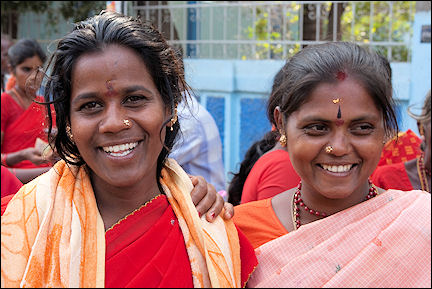
|
Along the Bay of Bengal from Chennai (Madras) to the most southern spot in India, where you see the sun rise from the sea in Kanyakumari and can see it set in the sea as well. On the way there are many Hindu temples, rice paddies, ploughing waterbuffalo, old forts and pilgrims in bare feet. If you need to ask for directions, just wake up the officers at the police station.
Travelogue & photos: Aart & Gerrie Dijkzeul
If it were only for the town names, a trip to South India would already be worthwhile: Mamallapuram, Tirukkalikunram, Vedantangal, Tiruvannamalai. These are the places we pass through on our bikes. Pure poetry.
The first day of biking always is hard. The time difference, temperatures about 30 degrees higher than at home, all those new impressions.
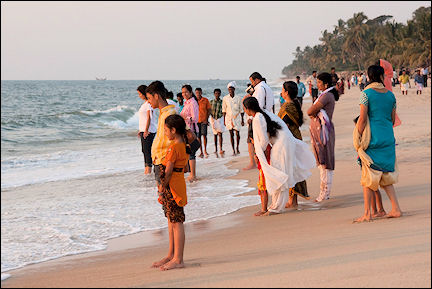
|
We take it easy in Mamallapuram, a town 60 kilometers south of Chennai (formerly Madras) in Tamil Nadu. We reassemble our bikes and stroll along stalls with the universal junk, together with many Indians.
The few Western tourists here are baking in swim trunks or bikinis on the beach north of the Shore Temple on the Bay of Bengal. There are also many Indians on the beach, but they remove their slippers at most when they take a dive.
Vedanthangal
We wake up the police officers to ask for directions
The real biking begins with a leg to bird park Vedanthangal, a fifty kilometers distance. We succeed in making it ninety. We have a route description which turns out to be useless when it really matters. In combination with our, for Tamils incomprehensible, pronounciation of the name of the bird park, this leads to a wild goose chase from north to south and east to west.
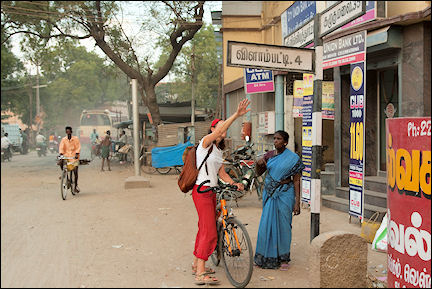
|
If they only would say they don't know. But no, directions are given with much gesticulating. The most confusing are the head movements, which can be interpreted as nodding yes, shaking no, or a neck dance.
It looks as if we aren't being taken seriously, are considered basket cases. We were warned: in this region Indians say "yes" this way. But despite that knowledge we still feel uncomfortable.
Fortunately there is a police station. The three officers there are sleeping on their watch. One lies stretched out on his desk. The other two are sleeping in a chair and on a wooden bench. They don't seem embarrassed at all when we wake them up - they explain how to get to the bird park. It's somewhere else, far from here.
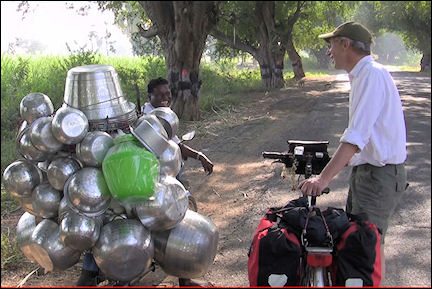
|
Armed with new directions and the name of the park in Tamil written on an old piece of newspaper, we eventually find the 30 hectare Vedanthangal Bird Sanctuary which is home to cormorants, herons, storks and pelicans.
The Forest Resthouse where we spend the night is an old colonial building with rooms big enough to get lost in. The caretaker is friendly enough to prepare us a meal, which we eat in the bare, huge conference hall.
In the evening we take a walk. We see fireflies and talk with a friendly old man who tells us everything about his children. When we come back, the guesthouse is dark and closed. We knock on doors, rattle the windows; nothing works. We then walk toward a light in the distance, which turns out to be where the caretaker lives. Problem solved.
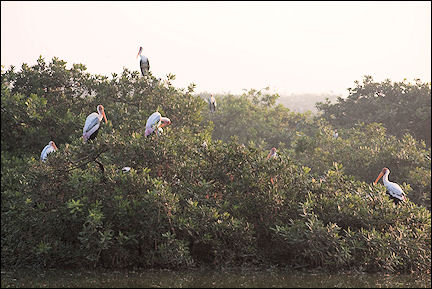
|
We set the alarm for 5:30 AM to be in the bird park on time. We needn't have done that: at 4:30 AM we sit straight up in our bed because of loud singing in the local Hindu temple. Muslims are noisy, but don't understimate Hindus: what a racket!
The birds do what we have paid for: they sit in trees and bushes with their long legs and bills and sometimes they fly up.
Tiruvannamalai
The temple elephant touches our heads with its trunk for a penny
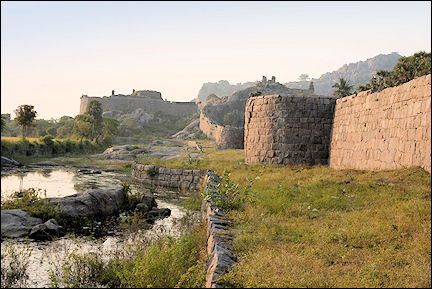
|
Via Gingee, with its 13th - 17th centuries forts, we bicycle to Tiruvannamalai, which is a place of pilgrimage for many Indians. This because of the impressive Annamalaiyar temple complex which covers about 10 hectares. Parts of the complex date from the fourteenth century.
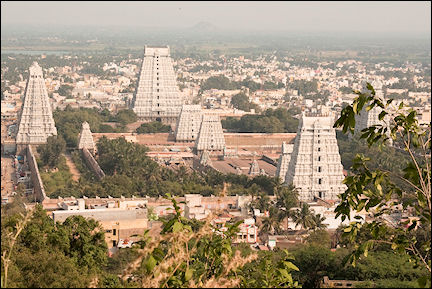
|
In the afternoon we climb Mount Annamalai, where we have a great view of the city and the temple complex at the foot of the mountain. We visit the cave where Ramana Maharashi, a famous guru, spent fifty years in contemplation. It turns out he still has lots of followers.
Yogis dressed in loincloths are coming out of the woodwork. Their hair hasn't been washed or cut in fifty years. It reminds us of the sixties. The Beatles studying with the Maharishi, women with flowers in their hair, India dresses.
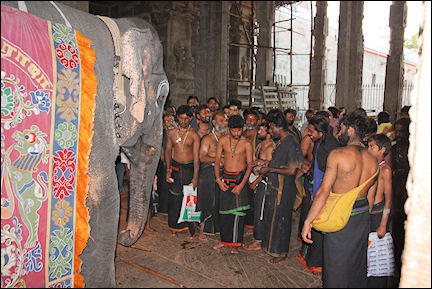
|
The visit to the temple makes a great impression. Thousands of Indians in beautiful clothes; the temple elephant touches our heads with its trunk after we put a penny in it. There are rituals we don't understand. The atmosphere is mystical and makes us quiet.
In the evening we look for something else than the sensible vegetarian food we've been having over the last few days. And beer, don't forget beer: it's as if it's rationed here. But no luck, on both counts.

|
We end up near the ashram at a restaurant mainly visited by Westerners for whom the sixties never ended. And of course, also here those delicious, vegetarian Indian dishes. No steak, no beer.
Kumbakonam
Waterbuffelo plough the fields, women plant rice
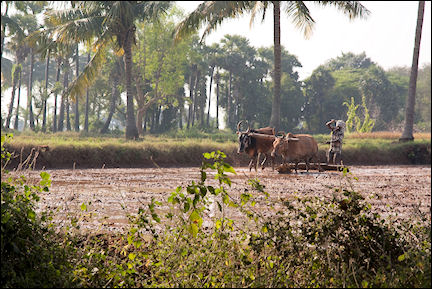
|
We ride our bikes via Pondicherry and Chidambaram to the temple city of Kumbakonam. In and around Kumbakonam are countless temples.
The first part of the route is wonderful; rice paddies all around. Waterbuffalo plough and level the fields, men in loincloths collect young rice plants. Women in long skirts plant them. Ripe rice is mowed and threshed. And all of this in a landscape with scattered basalt blocks. We enjoy ourselves.
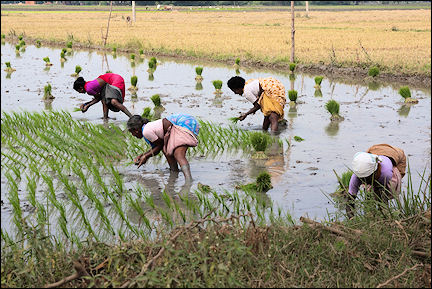
|
When we approach Pondicherry it gets busier. On and along the road is a lot of activity. We end the day in a fancy resort. The Indians here bow for us and don't give us a chance to carry our own luggage.
Everything is clean and, even better: the place serves non-vegetarian food. There even is beer, although it's not on the menu. Everything is great.
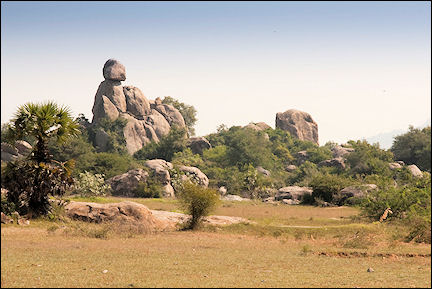
|
When we leave Kumbakonam the next morning, it rains. We didn't expect that. We have no rain wear, no umbrellas. The only thing we can do is wait until it's dry again.
Thanjavur
Everything with an engine honks
The (short) ride to Thanjavur would be beautiful, if there were no other traffic. But unfortunately, there is a lot of traffic and we have to pay attention all the time. The road is just wide enough for two buses to pass each other. But add two bicycles and there is a problem. Indian drivers swerve to the roadside when they see a situation like that develop. Risking our lives, we move a little to the right (Indians drive on the left side), just to teach them a lesson. Some postpone their overtaking manoeuvres, some don't.
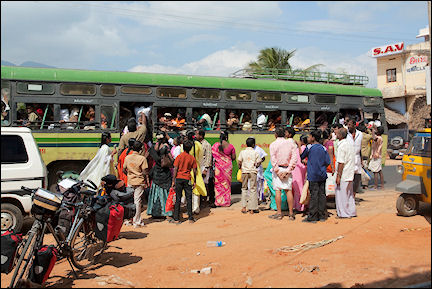
|
Another annoying aspect of traffic is the noise. Everything that has an engine honks. To let others know they're coming, to let them know they are there, to greet us and just out of habit. It's encouraged by the message on the backs of many trucks: Sound Horn.
And not just another horn. Even the crappiest Tata has a horn that rips your eardrums. At times this really takes the fun out of bicycling. Biking with earplugs! Maybe the problem will solve itself in the coming days. The drivers of the state oil company are on strike and many gas station are closed because of lack of fuel.
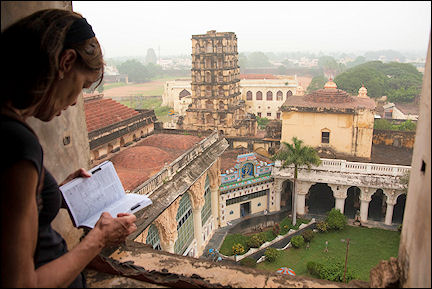
|
Thanjavur (Tanjore) is one of the oldest cities in India. In its town center is the Vijayanagara Fort, with the Royal Palace within its walls. The Brihadishwara Temple, dating from 1010 is on the World Heritage List.
Dindigul
An endless row of orange-clad pilgrims in bare feet
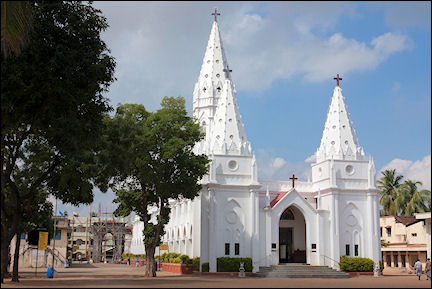
|
Fortunately, the route from Thanjavur to Trichy is the quiet kind. We don't have to bicycle on through-roads. What a relief! The area is a big network of natural bodies of water (Cauvery Estuary) and irrigation canals.
We visit the Basilica of Ponty. A beautiful, very large church in the middle of nowhere. A place of pilgrimage for Catholic Indians.
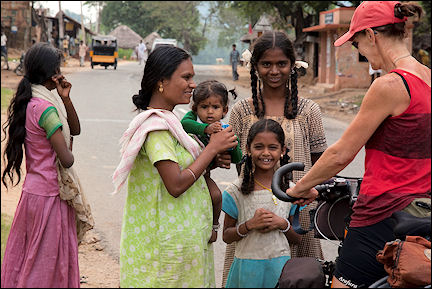
|
When we arrive in Trichy, the hotels we picked, turn out to be full. We pick another one opposite the bus terminal. Not a fortuitous choice. There isn't one bus with a horn, there are dozens.
A sign of hope are the lines of hundreds of people at the limited number of still working gas stations. They all carry 2-liter bottles, because that is the most they can get. Maybe it will be quiet in the city after all.
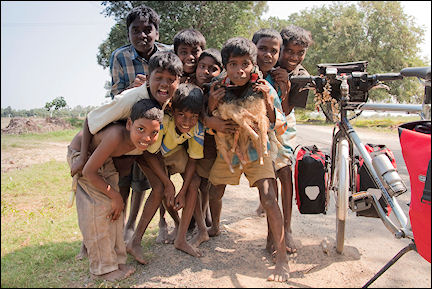
|
Tiruchirappalli, as Trichy is called in full, lies on the Cauvery rivir and is an ancient city as well: its history dates back to before the Christian era. The Vinakaya Ganesh Temple on an 83 meters high rock, at the top of stairs with 437 steps, is famous.
The next town on our route is Dindigul. The 90 kilometers road to Dindigul is a through-road that is currently being widened to four lanes. That is not a luxury. It's crowded and boring. We keep in mind that it could be worse.
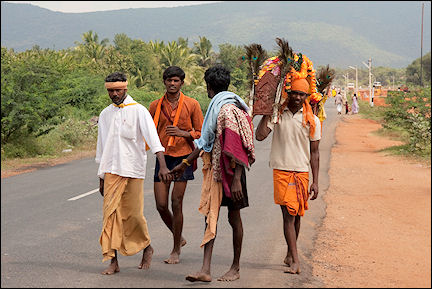
|
After 20 kilometers we see an endless row of mostly orange-clad Hindus in bare feet on a pilgrimage, going in the same direction as we are. At that point they are still full of energy and happy. After 50 more kilometers, when they take an exit, the freshness is gone.
Dindigul is a city with a population of over a hundred thousand with nothing worth menioning in the Lonely Planet. That's why it's fun to visit. We probably are the only western visitors here. The place looks affluent: well-maintained roads, no garbage in the streets. Stores offer everything we can find at home. Except for skates. The transportation workers' strike is over.
Madurai
We pass a village with dozens of rope-makers
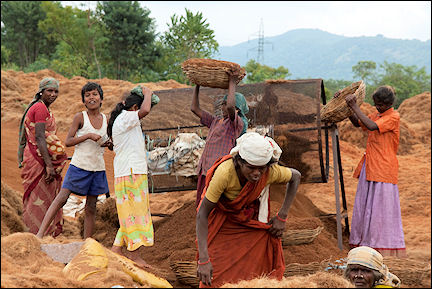
|
The logical route from Dindigul to Madurai is on the same type of road we were on yesterday. So we take the unlogical route. That works out well. The road is quiet and leads through a varied green landscape with mountains in the background.
In a village with dozens of rope-makers we see how coconuts are made into rope. The female rope-makers are very distracted by our visit.
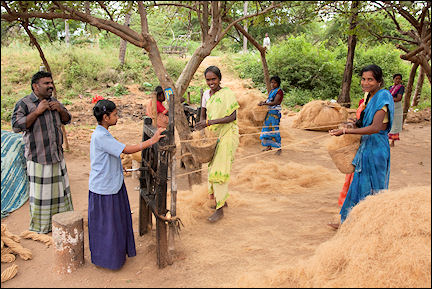
|
To the boss' displeasure the spinning frequently goes awry, which causes weak spots in the rope. If we hear about sugarcane cargo falling off trucks, we won't be surprised.
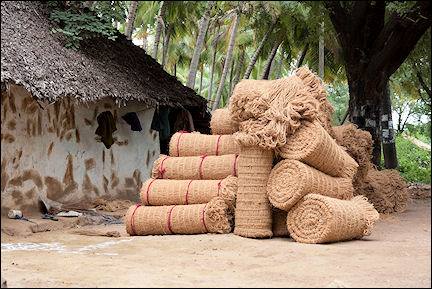
|
Madurai is a city with a population of over a million. It also has its own famous temple (Minakshi Temple) and a Ghandi Museum. In a good mood we get on our bikes to go there. Immediately we regret it. We are in the middle of the morning rush hour. Closed in on all sides, we are carried along amidst deafening honking.
Even though nobody ahead or behind him can move, the driver of the car next to us honks incessantly. It helps when we knock on his window with painful facial expressions. In a few weeks it'll all be different in Indian traffic. Mark my words.
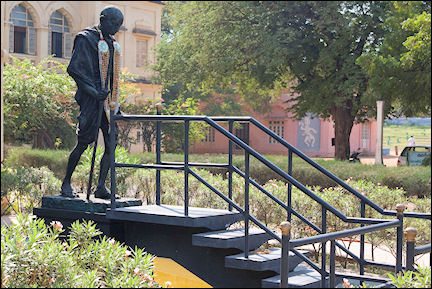
|
The Ghandi Museum is a simple but very informative museum about the Indian struggle for independence which started mid-nineteenth century. Ghandi's story is impressive because his teachings of non-violence had such a strong influence on the history of this great country.
Kanyakumari
The most southern city of India
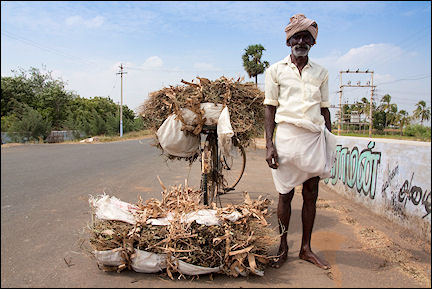
|
A two-day ride takes us via Sivakasi and Tirunelvelli to Kanyakumari. We ride on roads that are not on the map. Every time we just have to hope that the road won't end somewhere or will lead us in the wrong direction. This happens a few times, which makes the ride longer than planned. Our GPS is fortunately helpful.
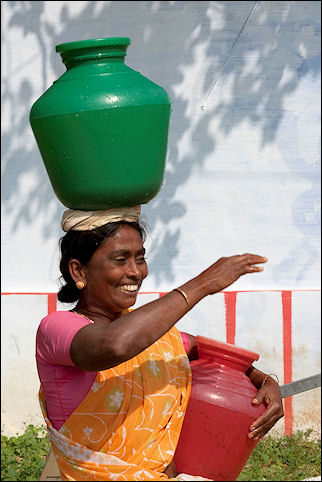
|
There is a lot to see on the way: peacocks with and without long tails, a meters long snake, thick as a fist, monkeys and villages where shabby huts are alternating with brightly colored houses. Sometimes even villas.
Many Indians walk barefoot. Women wear tops and long skirts and everything in between is covered with meters of fabric.
Many men wear a longi, a wraparound skirt that reaches the ankles. Because its length impedes their movements, the bottom is tied around the middle which makes the skirt a workable knee-length.
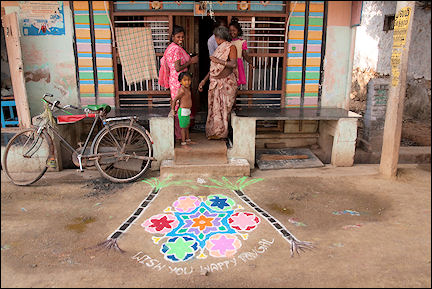
|
It's Pongal, the Tamil harvest festival. In front of many houses the sidewalk is decorated colorfully with the text Happy Pongal. Almost everywhere festivities are going on.
The first time we want to stop to watch, things go wrong. Everyone in the audience turns and walks toward us. The master of ceremonies has lost their attention. We get back on our bikes and ride on.
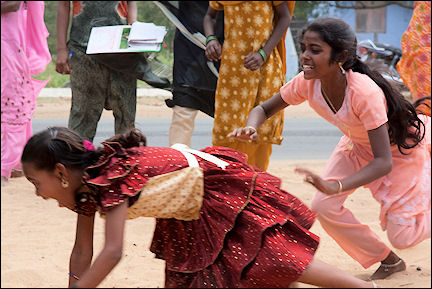
|
The second time we stop, one of the organizers comes running toward us. Come with me, come and look. The local old people are chased from their spot to make room for two chairs for the bicycling guests. In the Tamil (the regional language) speech that sounds from speakers, we frequently hear the word cyclist.
We are witnesses to a local version of musical chairs: the stone dance. In a next town the scene is repeated. Here the noble game of bite-the-cake is practiced. We don't see sack races, but we see girls play tag in a way that escapes our understanding.
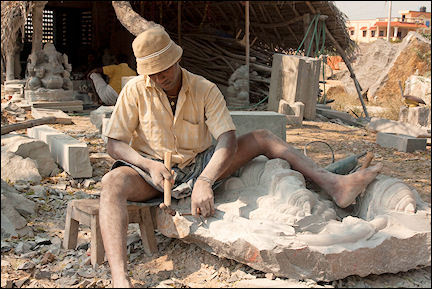
|
The last leg to Kanyakumari almost rides itself. We have a strong northern tail wind. There probably always is a strong wind here, because we bicycle through a forest of windmills. For dozens of kilometers we see thousands upon thousands of windmills.
Seeing the sun rise and go down again is nothing special, except when you can stay in the same place for both. We are at that spot in Kanyakumarim, India's most southern city.
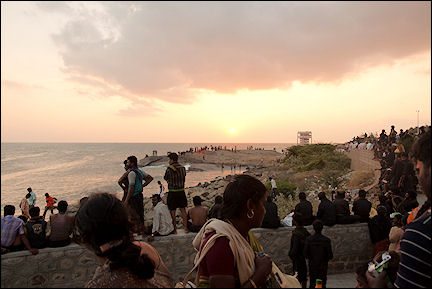
|
We are here together with tens of thousands of darkhaired pilgrims dressed in black who come to worship one of the many thousands of Hindu gods (Devi). They combine this with a visit to the annual fair. Where they spend the night? No idea. In any case there fortunately are still rooms for rent.
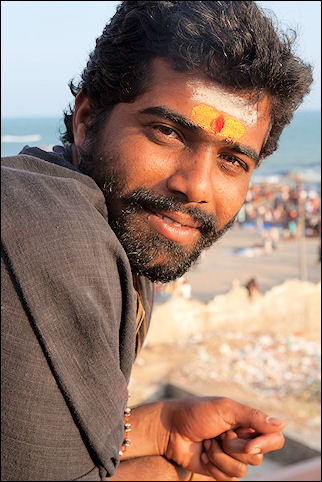
|
In the evening we visit the Ghandi Memorial. Just as in the temples everyone has to take off their shoes on entering the grounds. It is a nice building which sits at the most southern spot in India. We wait until the sun disappears in the sea and then pick up our shoes at the stall where we left them for safekeeping.
We're not the only ones. We expected that the British influence would still be noticeable, but it isn't. One moment we're in the second line for the shoe stall, the next moment we are in the fourth. Politely explaining that jumping the line is not nice doesn't help.
Only when we apply the same dirty tricks as the Indians (f.i. using our elbows) we make it to the first row. And there we have the advantage that our arms are longer than those of our fellow shoe-retrievers.
We leave Tamil Nadu and arrive in Kerala: Bicycle Vacation Kerala and Karnataka